Mills in Alto Aragón - harinero, central eléctrica
Yésero
Yésero is situated in the
Alto Gállego regio and is on the road from
Biescas towards
Torla and the famous
Ordesa National Park. Pass the Tunél de Gavín and park your vehicle at the branch to Yésero.
The mill is down in the river bed (1) at the confluence of the
Barrancos del Infierno and
de Lanaza.
Pictures: xii.1997, 27.xii.2003

(1) The mill at the confluence of the Barranco del Infierno and Bco. de Lanaza.
The workplace (2) of the grain mill occupied the largest part of
the ground floor. At the far end there was one hurst frame with one couple of stones (2 right).
In the space between the hurst frame and the window a cernedor, a bolting machine, (2 left, 3) can be seen.
Next to the entrance stood a limpia, a corn cleaning machine (4).
The short sides of the limpia carry some indications. The side which is on the left in (4), shows a large curved arrow accompanied with the
text 380 V
(10).
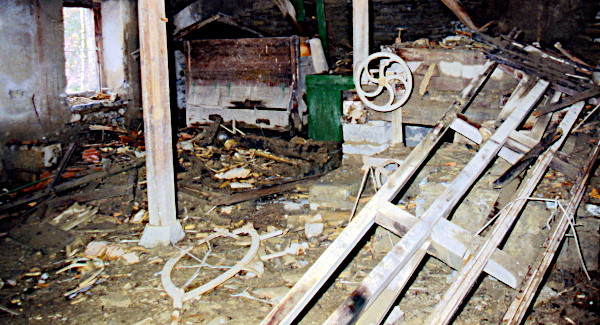
(2) The workplace occupies about the whole ground floor.
The V
cannot stand for voltage because the limpia is driven by pulleys and a belt
and not by electricity. De V
most likely stands for Vueltas
which means revolutions. The number given is in any case the
right number of revolutions per minute for this type of equipment.
The side which is on the right in (4) is marked with № 1
.
There is no indication of the supplier. Several suppliers have a No. 1 in their catalogue and this is always the smallest model
with a processing capacity of 6 to 8 fanegas (in Aragón this is 22.46 litres) per hour.
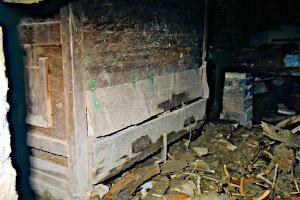
(3) Flour sifter (cernedor).
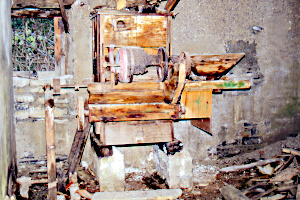
(4) Limpia, cleaning machine
with inscriptions №1
and 380 V
.
An octogonal stone case (6, guardapolvo) covers a single
couple of stones. Some parts of a silent feeder system (
†) are stil in place.
Notice also the wooden crane (5, grua) with its arms resting on the floor (2 foreground).
The most interesting part, however, is located under the hurst frame:
it is a turbine known as
Fontaine-Girard (7, see also
‡). In our entire study area we know of only a couple of mills equipped with this type of turbine (e.g. in
Gistain,
Broto,
Alcampell).
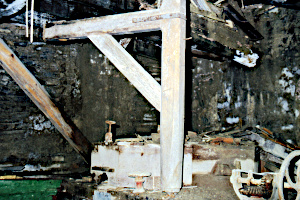
(5) The crane (grua).
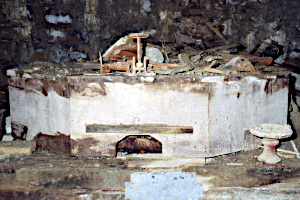
(6) Stone case with remains of feeding system.
This turbine is originally a design from the early days and developed around the middle of the 19th century by Pierre-Lucien
Fontaine from Chartes. He
got patents for his turbine in 1840, and for improvements in 1843.
Fontaine had a broad interest and, for example, also owned a patent (1879) for a better positioning of the blade in a safety razor.
Another Frenchman, Louis-Dominique Girard, further developed the Fontaine system, after which this type of turbine was spread throughout Europe.
In Spain, Joan Planas
Castañer, a textile manufacturer from Girona, was an important player. In 1858 Joan Castañer acquired the exclusive right to manufacture and sell the Fontaine turbine in Spain.
His success meant that later on several others, including Averly and La Maquinista Terrestre y Marítima, who we have met several times in mills in the area, also began producing this new hydraulic engine. And they all released their own perfected version.
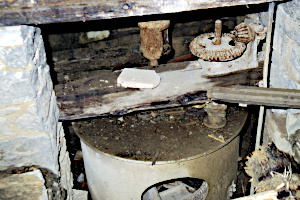
(7) Turbine Girard.
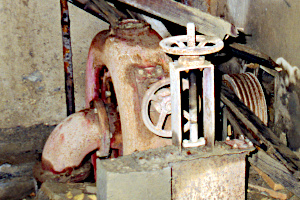
(8) Second turbine.
In a Fontaine turbine the entire system is outside the water! This is a great advantage over other types of turbines, because repairs, inspections and lubrications are more easy. But if the existing (often wooden) wheel had to be replaced, many smaller mills preferred a metal wheel. After all, that required even less maintenance and they were more familiar with a horizontal wheel than with those modern novelties.
A thin internal wall separates a small space near the entrance from the rest of the ground floor.
At the time of our visit the small space only contained a turbine (8) and nothing else.
On the maps of the Instituto Geográfico Nacional,
the mill is always accompanied by the text Fábrica de Luz
(folio 177, ed. 1936, 1952).
This small room must have been the place where electricity was generated.
All the usual contraptions where removed; only bolts and some isolators where left behind.
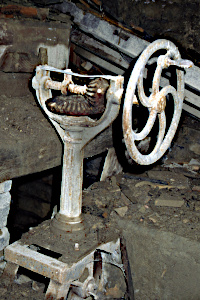
(9) Regulator of the Girard turbine.
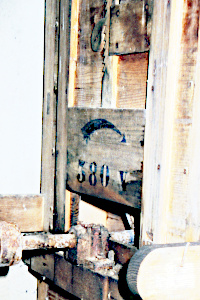
(10) Text on the limpia.

(11) Chimney says Año 1943.
This second turbine (8) must have had a double function. An axle protrudes through the wall
to the grain mill. There are pulleys on both sides. In the mill ribbons powered the grain cleaner and other equipment.
It is not clear whether the turbine had both competing functions (generating electricity and driving equipment) at the same time.
That must have been difficult, maybe impossible even. Perhaps the connection to the mill was only made after Yésero was connected to the Biescas power station in the 1950s and electricity was no longer produced here.
According to the land registry, the mill was built in 1910, but there must have been major renovations later, because the year 1943 can be seen in large numbers high up on the chimney (11).
† Vanhercke, L. & Anselin, A.
— 2023 — A la búsqueda de Molinos. El alimentador silencioso.
el Gurrión xi.2023, N° 173. Labuerda, I.S.S.N.: 1130-4960. pp. 21–26.
‡ Vanhercke, L. & Anselin, A.
— 2024 — A la búsqueda de Molinos. Un molino en Yésero.
el Gurrión xi.2024, N° 177. Labuerda, I.S.S.N.: 1130-4960. pp. 22–25.














